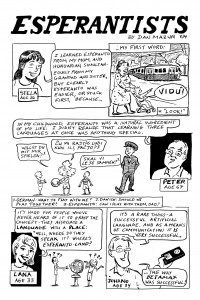New comic about Esperanto! Posted by Chuck Smith on Nov 1, 2014 in Uncategorized
The American comic artist, Dan Mazur, published a 12 page comic about native Esperanto speakers. The comic appeared as part of a comic anthology about subcultures. Libera Folio interviewed the author and you can read the Esperanto translation here.
How did you get the idea? What was your objective?
Earlier this year, I was beginning the work of publishing an anthology of short original comics, by various artists, on the subject of “subcultures,” so I was thinking about interesting subcultures, and I thought of Esperanto speakers as a topic. I didn’t know much about Esperanto, though I’ve known of it since I was a child. I had a vague notion of it going back to the early 20th century, and some association in my mind (probably erroneous) with utopian or idealist movements like the Fabian society. I thought it would be a pretty multi-faceted subculture, since it goes so far back. On my first Google search on the topic, I came upon an article about native Esperanto speakers, and this surprised and fascinated me… native speakers seemed like a subculture within the subculture! At this point I decided that I wanted to write and draw this story myself. I then watched a YouTube interview with Lana Shlafer [below], which had been shot in 2000, and I learned more.
How did you gather the material?
Though I am a cartoonist, I’ve also worked as a journalist, so I wanted to be able to interview a subject for the story. The only local contact I could find was the MIT Esperanto Society. This society turned out to be inactive, but I heard back from a former member, Erin Piateski. She helped with some contacts, and soon I was in touch with 5 Esperantists a mix of Europeans and Americans, four out of five were native speakers, so it was a good mix. I interviewed via email, except for Julie Schwartz, who lives nearby, so we were able to meet. For Lana Shlafer, I used quotes from her YouTube interview. With so many “voices,” I decided to structure the story like a comics-documentary, weaving the interviews together with a little history. I found that there was much in common among the native speakers, especially, but interestingly some differing attitudes toward Esperanto culture emerged as well.
When it was written, as a script, I sent it out to all the subjects for their approval, then I drew the comic. I went back and forth a lot with the subjects to make sure I didn’t make any mistakes in the Esperanto I use in the comic. As you probably have figured out, I don’t speak or read Esperanto myself. Working on this story has made me interested in learning it… Esperanto speakers seem to have a lot of fun!
Where was your comic strip published? What kind of reactions have you received?
The book, SubCultures: a Comics Anthology was published in September, including the story “Esperantists,” which is 12 pages long. As for reactions, i find that people are very interested in the subject matter — many people I talk to have little or no idea at all what Esperanto is. I’m starting to get some interest from Esperanto sources, such as yourself!
The book is available on my publishing website.

Build vocabulary, practice pronunciation, and more with Transparent Language Online. Available anytime, anywhere, on any device.
About the Author: Chuck Smith
I was born in the US, but Esperanto has led me all over the world. I started teaching myself Esperanto on a whim in 2001, not knowing how it would change my life. The timing couldn’t have been better; around that same time I discovered Wikipedia in it’s very early stages and launched the Esperanto version. When I decided to backpack through Europe, I found Esperanto speakers to host me. These connections led me to the Esperanto Youth Organization in Rotterdam, where I worked for a year, using Esperanto as my primary language. Though in recent years I’ve moved on to other endeavors like iOS development, I remain deeply engrained in the Esperanto community, and love keeping you informed of the latest news. The best thing that came from learning Esperanto has been the opportunity to connect with fellow speakers around the globe, so feel free to join in the conversation with a comment! I am now the founder and CTO of the social app Amikumu.





Comments:
Frith Ra:
I try not to be too pushy about these things, but I have been drawing an Esperanto webcomic since 2006. I believe that my command of the language is finally getting up to international standards (I’m one of those people who are apparently “immune” to languages)
If your readers wish to read my efforts (I just do the art & translate the English stuff written by the webmonkey) the Esperanto version can be found at http://www.littlelevers.com/angxeloj.
Please leave comments in our shiny new “Disqus©” boxes (just installed this week) underneath the strips.
And thank you for the chance to discuss this.
Grishgo:
@Frith Ra I’d been looking for Esperanto comics, so I’m very glad to come across your comment!